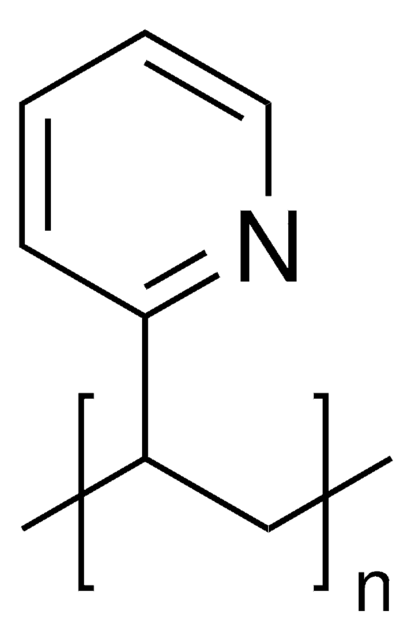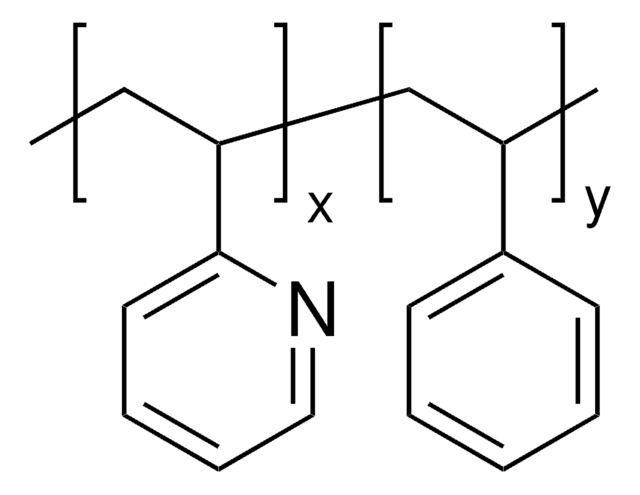523321
Poly(2-vinylpyridine)
analytical standard, average Mw 37,500 (Typical), average Mn 35,000 (Typical)
Sign Into View Organizational & Contract Pricing
All Photos(1)
About This Item
Recommended Products
grade
analytical standard
Quality Level
mol wt
average Mn 35,000 (Typical)
average Mw 37,500 (Typical)
technique(s)
gel permeation chromatography (GPC): suitable
format
neat
InChI
1S/C7H7N/c1-2-7-5-3-4-6-8-7/h2-6H,1H2
InChI key
KGIGUEBEKRSTEW-UHFFFAOYSA-N
Looking for similar products? Visit Product Comparison Guide
Application
- Synthesis and Structural Insight into Poly(dimethylsiloxane)-b-Poly(2-vinylpyridine) Copolymers: This study delves into the synthesis of poly(dimethylsiloxane)-b-poly(2-vinylpyridine) copolymers, highlighting their structural characteristics and potential applications in creating hybrid materials with unique properties (Avgeropoulos et al., 2023).
- pH Tunable Patterning of Quantum Dots: Research discusses the utilization of poly(2-vinylpyridine) in pH-sensitive patterning for quantum dot arrays, offering a versatile approach for developing advanced photonic devices (Onses et al., 2024).
- Dynamic Photonic Janus Colloids with Axially Stacked Structural Layers: The study presents the application of poly(2-vinylpyridine) in the formation of dynamic photonic Janus colloids, which could lead to innovative solutions in sensor technologies and display systems (Ku et al., 2024).
- Polyhedral Colloidal Clusters Assembled from Amphiphilic Nanoparticles in Deformable Droplets: Demonstrates the role of poly(2-vinylpyridine) in assembling complex colloidal structures, which may be crucial for the development of novel biomaterials and drug delivery systems (Jiang et al., 2023).
signalword
Warning
hcodes
Hazard Classifications
Eye Irrit. 2 - Skin Irrit. 2 - STOT SE 3
target_organs
Respiratory system
Storage Class
11 - Combustible Solids
wgk_germany
WGK 3
flash_point_f
Not applicable
flash_point_c
Not applicable
ppe
dust mask type N95 (US), Eyeshields, Gloves
Choose from one of the most recent versions:
Already Own This Product?
Find documentation for the products that you have recently purchased in the Document Library.
Customers Also Viewed
Keewook Paeng et al.
The Journal of chemical physics, 134(2), 024901-024901 (2011-01-19)
A temperature-ramping anisotropy measurement is introduced as an efficient way to study molecular motion in polymer glasses. For these experiments, fluorescent molecules were dispersed in the polymer glass and the reorientation of these dyes was used as a probe of
Weihua Tao et al.
Journal of hazardous materials, 175(1-3), 111-116 (2009-11-03)
In the present study, the performance, behavior and mechanism of synthetic poly(2-vinylpyridine) resin (WH-225) adsorbing 5-sodiosulfoisophthalic acids (SIPA) from the aqueous solution were investigated, and two commercial adsorbents, namely, hypercrosslinked adsorbent NDA-100 and macroporous adsorbent XAD-4 were employed as reference.
Tianying Jiang et al.
Journal of physics. Condensed matter : an Institute of Physics journal, 24(37), 375109-375109 (2012-08-24)
Here we investigate the flow properties of suspensions of dicolloidal particles composed of interpenetrating spheres where one sphere is rich in polystyrene and the second is rich in poly 2-vinyl pyridine. The synthesis method is designed to create both anisotropic
Natalia Kocharova et al.
Langmuir : the ACS journal of surfaces and colloids, 23(6), 3363-3371 (2007-02-13)
We report the efficient aqueous dispersion of pristine HiPco single-walled carbon nanotubes (SWNTs) with ionic liquid (IL)-based surfactants 1-dodecyl-3-methylimidazolium bromide (1) and 1-(12-mercaptododecyl)-3-methylimidazolium bromide (2), the thiolation of nanotube sidewalls with 2, and the controlled self-assembly of positively charged SWNT-1,2
Oleksandr Trotsenko et al.
Langmuir : the ACS journal of surfaces and colloids, 28(14), 6037-6044 (2012-03-15)
Conformations of cationic polyelectrolytes (PEs), a weak poly(2-vinylpyridine) (P2VP) and a strong poly(N-methyl-2-vinylpyridinium iodide) (qP2VP), adsorbed on mica from saline solutions in the presence of counterions of different valences are studied using in situ atomic force microscopy (AFM). Quantitative characteristics
Our team of scientists has experience in all areas of research including Life Science, Material Science, Chemical Synthesis, Chromatography, Analytical and many others.
Contact Technical Service









